

Selling Sustainability: Priming for Marketers. Pope Francis, in Sweeping Encyclical, Calls for Swift Action on Climate Change. Waste to Energy Plants on the Rise - Forester Network. While waste to energy (WTE) is the third-most-preferred municipal solid waste approach behind source reduction/reuse and recycling/composting, some 29 million tons of MSW—12% of total generated—were combusted for energy recovery in 2011, according to “Municipal Solid Waste in the US: Facts and Figures.”
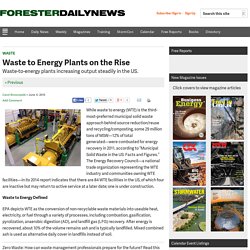
The Energy Recovery Council—a national trade organization representing the WTE industry and communities owning WTE facilities—in its 2014 report indicates that there are 84 WTE facilities in the US, of which four are inactive but may return to active service at a later date; one is under construction. Waste to Energy Defined. A solar future isn't just likely — it's inevitable. I plan to write a great deal about the short-term prospects for clean energy, both economic and political, but I want to begin life here at Vox with an imaginative exercise, a bit of musing about what energy might look like in the future — not 10 or 20 years from now, but 50, 70, even 100 years ahead.
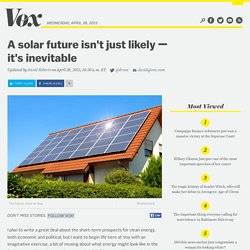
Obviously, predicting the far future is a mug's game if you take it too seriously. This post is more about storytelling, a way of seeing the present through a different lens, than pure prognostication. But storytelling is important. And insofar as one can feel confident about far-future predictions, I feel pretty good about this one. Here it is: solar photovoltaic (PV) power is eventually going to dominate global energy. The main reason is pretty simple: solar PV is different from every other source of electricity, in ways that make it uniquely well-suited to 21st-century needs.
Solar PV is different from other electricity sources — in one crucial way But not much energy. This affordable housing complex has a solar farm on its roof. Solar Streets: New Roadways May Ditch Asphalt for Energy-Generating Sunshine Collectors. As a kid in the 1960s, before most people had even heard of solar power, Scott Brusaw imagined “electric roads.”
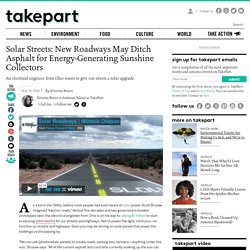
Almost five decades and two government-funded prototypes later, the electrical engineer from Ohio is on his way to raising $1 million to start producing solar panels for our streets and highways. Not to power the light, mind you—to function as streets and highways. Soon you may be driving on solar panels that power the buildings you’re passing by. “We can use [photovoltaic panels] to create roads, parking lots, tarmacs—anything under the sun,” Brusaw says. “All of the current asphalt and concrete currently soaking up the sun can be covered with our technology to turn that sunlight into clean, renewable electricity.” The biggest challenge Brusaw faced was engineering a case to protect the fragile solar cells. FEMA to deny funds to climate change deniers. Katherine Bagley, INSIDECLIMATE NEWS Posted: Sunday, March 22, 2015, 1:09 AM The Federal Emergency Management Agency is making it tougher for governors to deny man-made climate change.
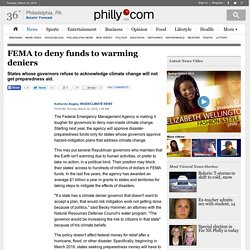
Starting next year, the agency will approve disaster-preparedness funds only for states whose governors approve hazard-mitigation plans that address climate change. This may put several Republican governors who maintain that the Earth isn't warming due to human activities, or prefer to take no action, in a political bind. Their position may block their states' access to hundreds of millions of dollars in FEMA funds. Portland Now Generates Electricity From Turbines Installed In City Water Pipes. Your shower is wasting huge amounts of energy and water. Here’s what you can do about it. Boston’s Winter From Hell. Photo.

Citigroup sets aside $100 billion for green initiatives. Citigroup has set aside $100 billion to fund environmental projects over the next decade, doubling the amount it had earmarked for such projects in 2007.
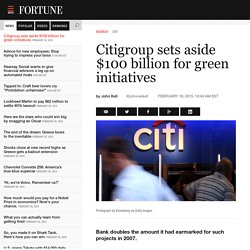
The investment in renewable energy and energy efficiency projects is meant to help reduce the effects of climate change. The bank said that it would focus on financing greenhouse gas reductions and resource efficiency in other sectors, such as sustainable transportation. Citigroup C 1.29% also intends to finance initiatives focused on clean water and waste management, as well as green housing. The announcement is a continuation of a focus on renewable energy that the bank has touted in recent years. The company in 2007 announced a $50 billion financing goal for green projects and met that threshold three years before it had anticipated in 2013. Citi has increasingly focused on environmental sustainability, with investments into such financing increasing over the past several years. WA State NDRC - Public Comment Documents. The State of Washington has been invited to participate in the Phase 2 of HUD’s National Disaster Resilience Competition (NDRC).
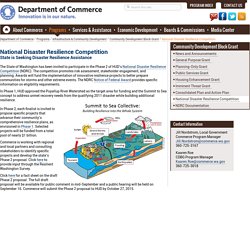
The competition promotes risk assessment, stakeholder engagement, and planning. Awards will fund the implementation of innovative resilience projects to better prepare communities for storms and other extreme events. The NDRC Notice of Federal Award provides specific information on eligibility requirements. In Phase 1, HUD approved the Puyallup River Watershed as the target area for funding and the Summit to Sea concept to address unmet recovery needs from the qualifying 2011 disaster while building additional resilience. In Phase 2, each finalist is invited to propose specific projects that advance their community’s comprehensive resilience plans, as envisioned in Phase 1. Convertible Sleeping Bags Turn Into Insulated Tents for the Homeless. Naomi Klein on why low oil prices could be a great thing. May Boeve, executive director of 350.org, recently interviewed Naomi Klein, activist and author of the book This Changes Everything: Capitalism vs. the Climate (and a 350 board member), as part of a web workshop ahead of Global Divestment Day.
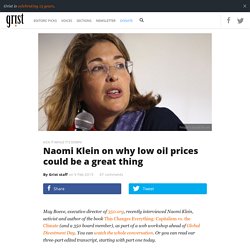
You can watch the whole conversation. 5 Ideas That Could Have Prevented Flooding in New York. New York City didn’t have to flood quite this badly, or, at least, it doesn’t have to again.

There's no shortage of ideas out there for how the city could adapt to rising sea levels (or, we’ll just say it: climate change). A lot of them haven’t been deployed or more seriously studied because they seem too expensive or daunting. But an event like Sandy quickly changes that calculus. Suddenly, some of these solutions don’t look quite as expensive as cleaning up after a hurricane: 1. Here's What Every Governor Thinks About Climate And Clean Energy. By Ryan Koronowski & Tiffany Germain - Guest Contributor Posted on Share this: "Here’s What Every Governor Thinks About Climate And Clean Energy"
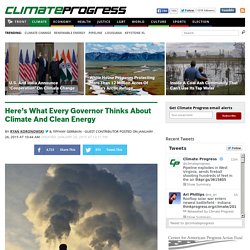
Life on Earth now officially at risk, scientists say. Humans are “eating away at our own life support systems” at a rate unseen in the past 10,000 years by degrading land and freshwater systems, emitting greenhouse gases, and releasing vast amounts of agricultural chemicals into the environment, new research has found. Two major new studies by an international team of researchers have pinpointed the key factors that ensure a livable planet for humans, with stark results. Users’ Guide: Climate messaging. Is “resilience” the new sustainababble? SustainAbility's 10 trends for 2015.
1. Scales Tip on Global Climate Change Action With rising civic activism, surging numbers of corporate commitments and more decisive action by local and national governments, global climate change diplomacy is showing new signs of life. Interactive: Carbon Emissions Past, Present and Future. Task Force on Climate Preparedness and Resilience Recommendations. Report: Infrastructure Crisis, Sustainable Solutions. Cost of Energy Efficiency Is under Half the Cost of Building Coal Power Plants. After mining the results of energy efficiency programs representing every US region, Lawrence Berkeley National Laboratory (LBNL) researchers have reported the initial result that the average total cost of saved energy is only 4.4 cents per kilowatt hour.
This means that smarter uses of energy can replace dirty coal at a fraction of the cost of building coal plants to generate electricity (and without polluting our air or exacerbating climate disruption).